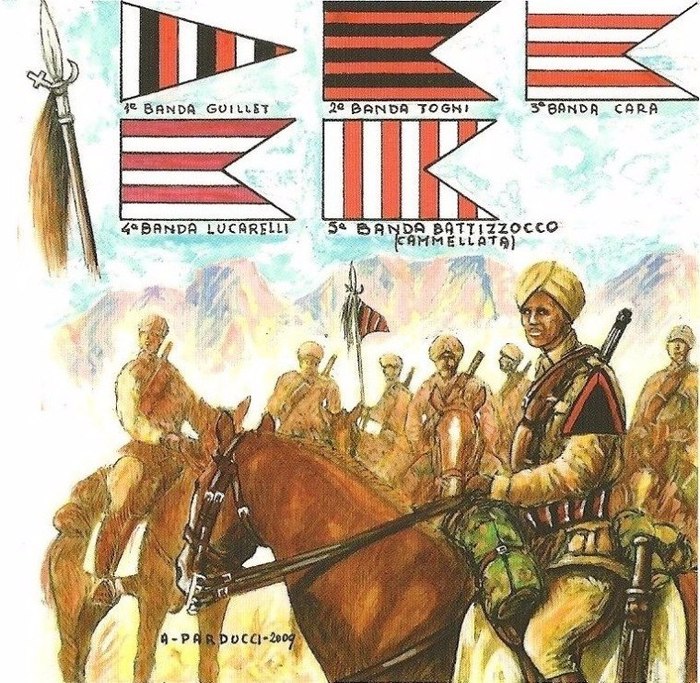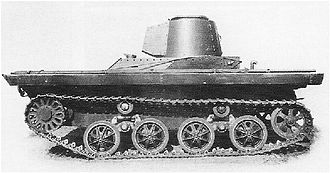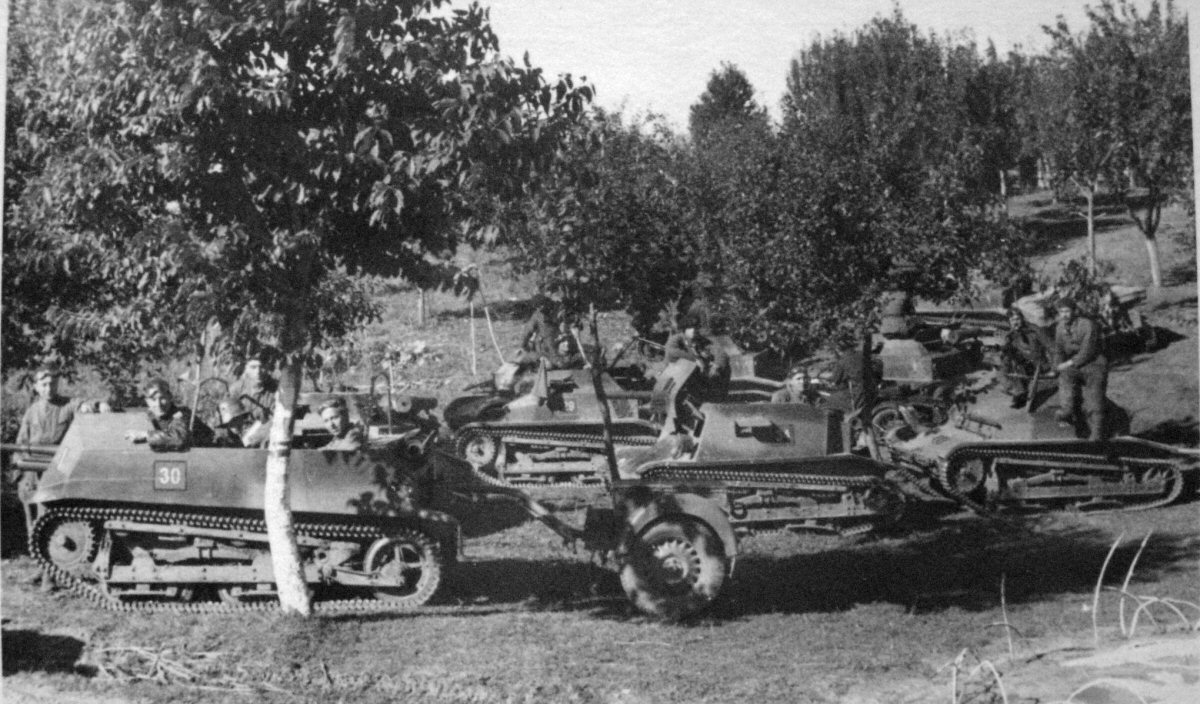A little-known page of history - organized guerrilla warfare in East Africa by a group of Italian officers .
After the victory in the Ethiopian war of 1935-36, the so-called Italian East Africa was created, with which Mussolini planned to start the creation of the second Roman Empire. Several tens of thousands of Italian troops were concentrated in the region, assisted by detachments of local residents. And this was already a real threat to British possessions in Somalia, Kenya, Egypt and Sudan.
With the entry of Rome into the war, the Italians seriously intended to interrupt the artery linking the Mediterranean Sea and the Indian Ocean - the Suez Canal. What's more - they captured British Somalia. After that, luck ran out - the British were angrier, and the Italians had serious supply problems. After a few months, the British regained theirs and launched a successful offensive.
Even during the battles of 1940-41, some Italian officers gave credit to the convenience of guerrilla tactics, in particular - using detachments from the local population.
So, on November 28, 1941, the last major Italian garrison in Africa, commanded by the Viceroy and Governor-General of Italian East Africa, Guglielmo Nasi, capitulated. However, not all descendants of the legionnaires agreed that this was the end of their epic. Nearly 7,000 Italian soldiers continued to fight in Ethiopia, Eritrea and Somalia against the British, hoping for a speedy victory for Rommel and the return of the shadow of the Lictorian fasces over the entire Mediterranean. The number of guerrillas named, however, was probably an order of magnitude smaller in practice. And the guerrillas were not always Italians, often the latter were only the commanders, the rest were representatives of local tribes. Major Gobbi's partisans operated in northern Ethiopia.
In early 1942, guerrillas appeared in Eritrea (Captain Aloisi's group helped Italian prisoners of war escape from British camps) and British Somalia. Most units obeyed orders from General Muratori, formerly head of the Fascist militia in the colony). One of its main successes was the instigation of an anti-English uprising of the Azebo-Galla tribe of the North Ethiopian Oromo people, which the British and Ethiopians managed to suppress only in early 1943.In addition to the guerrillas themselves, there was in Africa and the Italian underground. Thus, Colonel Luchetti created in the major cities of the former Italian East Africa underground organization "Front of Resistance" (Fronte di Resistenza), engaged in espionage and sabotage. In turn, as early as September 1941, the Blackshirts created in Ethiopia the organization "Sons of Italy" (Figli d'Italia), which began to terrorize the British and Italians who cooperated with them.
There were other detachments - Colonel Calderari in Somalia, Colonel Di Marco in Ogaden (eastern Ethiopia), under Colonel Ruglio in Danakil (mountain system in northeastern Ethiopia, southern Eritrea and northern Djibouti), Centurion Blackshirts (captain of the fascist militia) de Warde in Ethiopia. They acted quite successfully - the British had to transfer to this area additional units from Sudan and Kenya, including armored vehicles and aircraft. They also recalled the experience of the Anglo-Boer War - a significant part of Italians in the coastal regions of Somalia were driven into internment camps (including - in order to exclude their interaction with Japanese submarines).
In addition, local support for the Italian resistance began to fade in late 1942 after Rommel's defeat at El Alamein. In addition, the guerrillas lacked modern weapons and ammunition. On the other hand, the guerrillas had a hidden ally among yesterday's enemies - Emperor Haile Selassie I of Ethiopia, who allegedly promised his support in exchange for concessions in case of victory of the German-Italian coalition in Africa.
However, the information about the negotiations is based on the memories of the participants and can be, so to speak, slightly embellished. Another serious blow to the underground was the arrest of Colonel Luchetti.
The resistance of the Italian partisans held out until the summer of 1943, some of them laid down their arms already in the fall. The last of the guerrilla officers was Colonel Nino Tramonti, who fought in Eritrea.
African guerrillas also had their own supermen - say, nicknamed by the British "commander-devil" Lieutenant Amedeo Guillet. He led an Amhara cavalry unit that tormented British posts and convoys, then created a Tigray guerrilla unit in Eritrea.
In August 1943, having escaped capture, he managed to escape to his homeland and even persuaded the Ministry of Defense to allocate a plane with ammunition for the Italians fighting in Eritrea. The plan was thwarted only because the command signed an armistice with the Western allies.
Actually, the lieutenant has an extremely interesting biography, so let's dwell on it in more detail. Amedeo came from a noble family from Piedmont and Capua, in 1930 graduated from the Academy of Infantry and Cavalry in Modena. An excellent horseman, he was a member of the Italian Olympic team at the Berlin Games in 1936. Then he fought in Ethiopia and volunteered for the Spanish Civil War.
There he became an adjutant of General Luigi Fruschi (deputy commander of the Italian Volunteer Corps, then commander of the 20th Italian Division "Friuli"), without any help from influential relatives. Then there in Spain, he commanded a company of arditi (conventionally speaking - special forces) in the division "Fiamme Nere", then - a unit of Moroccans, received the Silver Medal for bravery. Then served in Libya, where he was in favor with the local governor.On his return to Italy, Guille disapproved of the rapprochement of his homeland with the Reich and the growth of anti-Semitism in Italy, and therefore asked for East Africa. Here he was engaged, conditionally speaking, counter-terrorist operation - leading the fight against the rebels loyal to the emperor-exile Haile Selassie I. As you can understand, this experience soon came in handy for him, but from a different angle....
The detachment of 2500 bayonets created by him in 1940 was called Gruppo Bande Amhara and was active in the rear of the British. Bande - not our "gang", but the Italian name for irregular semi-guerrilla units formed from natives. So this unit had only 6 European officers, a few Eritrean corporals, and the rest were Amhara (a people in Ethiopia) cavalrymen, mostly on camels, and Yemeni infantrymen. Keep in mind that Guillet was only a lieutenant, but managed to command such a large formation.
The lieutenant then formed an already 5,000-strong cavalry unit of Eritreans, called Gruppo Bande a Cavallo or Gruppo Bande Guillet. Among his soldiers, the commander enjoyed unquestionable authority, and the British spoiled the decisive and brave actions have so much blood that he earned the already mentioned nickname of "devil commander". However, Guillet was a worthy opponent, played though the devilishly cunning, but honestly, thanks to which he received two more nicknames - "Knight from the past time" and "Italian Lawrence of Arabia.
At the end of 1940, the British drove the lieutenant and his brigade into a vise. So the lieutenant dared the unthinkable - a mounted attack on British armored vehicles. Guillet personally led his subordinates, pelting the enemy with hand grenades and Molotov cocktails. The encirclement was broken through. It is interesting that just a year before that it was the efforts of Italian war correspondents that created a beautiful but unreliable legend about "reckless Poles attacking German tanks on horseback".
Guillé's detachment suffered heavy losses in battles with superior enemy forces (about 800 men killed in two years), but continued to torment enemy positions. Amedeo never tired of emphasizing the valor of his subordinates, saying that "the Eritreans are the Prussians of Africa, but without the disadvantages of the Prussians". After the defeat of the Italians in East Africa, he hid his uniform on an Italian farm and started his own war against the British, confirming his renown as "the devil". Even after the defeats, he managed to reach Yemen on his own (working as a laborer and water seller), where he befriended the imam's son and trained local soldiers. From there he made his way to Italy on a Red Cross ship.
As you know, Guilla failed to return to Eritrea, but he was promoted to major and assigned to military intelligence. And here - another scenario for a suspenseful series - because Italy was no longer an ally of the Reich, Amedeo was assigned to the British intelligence services. Moreover - he began to cooperate and even became friends with Colonel Harari.
And he, by the way, commanded the very commando squad, which unsuccessfully tried to catch Guillé in Africa. Warriors quickly found common ground and pulled off a couple or three still classified operations in the northern part of Italy, still occupied by the Germans. In 1944, Amedeo married, and later had two sons.
With the abolition of the monarchy, Amedeo planned to leave the country, but Umberto II personally asked the African hero to serve his country under any government. Amedeo, loyal to the Savoy dynasty even after its fall, could not disobey and went to university to study anthropology. Later he was in the diplomatic service, representing Italy in Yemen, Jordan, Morocco, and finally as ambassador to India. He then settled in Ireland, spending the winter months in his homeland.
In 2000, he was awarded honorary citizenship of the city of Capua, and the Italian President presented him with the Grand Cross of the Military Order of Italy, the country's highest military award.
The following year he visited Eritrea, where he was greeted by thousands of admiring supporters, including Amedeo's former subordinates. By the way, Guillet died, you will not believe, not so long ago - in 2010, at the age of 101 (!) years, twenty years outlived his wife. His centenary was celebrated with a special concert in Palazzo Barberini in Rome. In 2007, Italian television made a documentary about him. Guillet - one of the most decorated Italian soldiers, in his "asset" - also awards from Spain, Egypt, Vatican, Germany and Morocco.
Or here is a captain of Italian intelligence Francesco de Martini, who in January 1942 blew up an ammunition depot in the Eritrean port of Massawa. In the Royal Italian Military Information Service (and that was the name of the Italian Abwehr) got from the tank troops, went to the mountains immediately after the defeat - in November 1941. After sabotage in the port de Martini captured, but he managed to escape to Yemen, then returned to Eritrea. Here he formed a group of local sailors, which on small sailing boats successfully operated in the Red Sea, collecting intelligence on the British, which were transferred to Rome.
In August 1942, the captain was captured by the British commandos after another sabotage. He returned to his homeland in 1946 and, incidentally, received for African art no more, no less - the highest award of Italy for the feat on the battlefield - the gold medal "For Military Valor. De Martini served as far as a brigadier general (1962) and died in 1980 at the age of 77 years.
But the German Iron Cross for African partisanship was awarded to a woman, moreover - a representative of a rather peaceful profession - military doctor Rosa Danelli, a member of the Fronte di Resistenza. She personally managed to blow up (and, incidentally, survived) the main British warehouse in Addis Ababa in August 1942. Thus depriving the enemy of the latest "Sten" submachine guns, which the British would have greatly benefited from.
Italian guerrilla warfare did not have, of course, a significant impact on the overall course of the war, even Rommel did not help much. On the other hand, acting in difficult conditions, without reinforcements and supplies, the guerrillas managed to draw on themselves a relatively large force of British and Ethiopian troops, as well as providing Rome with intelligence, conducted a number of successful sabotage. In the end, this selfless struggle at least a little shook the image of the willless and cowardly Italian soldier.
 https://pikabu.ru/story/partizanskaya_v ... ke_5463885
https://pikabu.ru/story/partizanskaya_v ... ke_5463885















